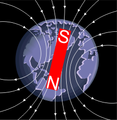Okay, I decided this warranted a Ranger Randy article. I had origionally only emailed it to a few of my more hard-core friends, because it gets technical, but everyone loved it, so what the hey, here it is:
My friend, coworker and fellow curiosity-junkie Hari recently stumbled across an article about some bar-tailed godwits (that’s a bird) who flew 7,100 miles non-stop and over water. On top of all the other reasons to be stunned and amazed by this feat, Hari wondered how these birds navigated all that open water. I told him that many birds have compass-like sensory mechanisms containing a naturally occurring magnetic mineral called magnetite. Hari, as if it was the most obvious follow-up question in the world, said, “I wonder what it does to them when the Earth’s magnetic poles reverse.”
It was the kind of great question that stopped me in my tracks. For decades I’ve known that birds navigate using Earth’s magnetic field, and for decades I’ve also known that the Earth’s magnetic field reverses periodically and the south magnetic pole becomes the north—but I’d never asked myself Hari’s question. How does a bird, whose behavior is largely instinctive, survive evolutionarily when the compass needle suddenly points south instead of north? It was too fun to pass up. I started digging.
The first thing I found out was that Earth’s magnetic field is even squirrelier than I thought. It does, as I knew, reverse itself, on average every 300,000 years, but that time varies hugely, from over a million down to just a few tens of thousands. The last time it happened was 780,000 years ago. But that’s not the important number if you’re a bird migrating by a magnetic compass. The important number would be “from a few hundred to a few thousand years.” That’s the time it takes for the flip to actually take place. That’s not very long in evolutionary terms. If these birds’ lives depended on genetically hard-coded migratory behaviors, I imagined that it would be hard for them to adapt in just a few thousand years.
But our magnetic field does even weirder things than that. Even when the magnetic north pole stays roughly at the north end of the planet, it can move around, as much as a few kilometers a year. I also knew this, because sailors, surveyors and hikers know it—it’s why they have to keep an eye on the copyright dates of their maps. The magnetic declinations change. But my favorite geomagnetic quirk was a weird thing called dipole tilt variation, in which the magnetic North Pole wanders south, even crosses the equator briefly, and then returns to roughly where it had been.
You just can’t trust that magnetic field to stay put. It’s all over the map.
Just as an aside, we know all this because of the ocean floors. Ocean floors are created by mid-ocean ridges, which can be pictured as linear volcanoes running down the middles of most of our oceans, constantly oozing magma along their length and creating ocean floor, which constantly moves outward from the ridge in both directions, until it hits a continent and gets sub-ducted (driven under the continent). When the magma at the ridge initially hits the cold ocean water and solidifies, that’s when the magnetic minerals in it get their orientation frozen. Ocean floors are giant conveyor belts, and the magnetic minerals in them are a perfect record, complete with fossil datestamps, of where north was at any point in time.
Anyway, Hari’s question has indeed been studied. Extensively. In fact, there’s a great debate about all this, including how in the heck these magnetoreceptors even work, why they’re in the vicinity of the optic nerve, and whether that means that birds can “see” our magnetic field superimposed over the landscape as they fly. (Dang, don’t you wish we spoke the language so we could ask them?)
Fun stuff, all of it, but I’m sitting here at my desk where I get paid paid to rearrange the magnetic orientation of iron molecules on the surfaces of spinning disks, and I actually have to get back to work at some point, so I’ll just recount the study I found most amusing, and then leave you all alone:
You can’t conduct tests by changing the orientation of the earth’s magnetic field, so one scientist did the next best thing: He changed the orientation of the magnetite in the birds’ brains. A fellow named Winklhofer zapped bird brains with a strong magnetic pulse, fritzing their magnetite so the “compass needle” pointed in a different direction (scientists do unkind things like this to animals all the time), and an interesting thing happened. Birds that had already flown their migration route at least once flew off in the wrong direction. But young birds who had never flown the route before had no problem. The conclusion?
The compass is hard-wired—but the map is learned.
A compass needle that points south is still a useful thing—as long as you learn your map accordingly.
Now you know.

